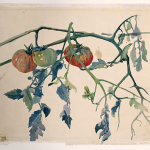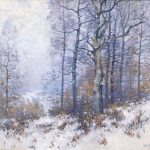Though the Museum is now internationally renowned for its collection of works by Louis Comfort Tiffany, the McKeans were less interested in “masterpieces” per se than in objects that exemplified important aspects of American art. But first and foremost, the McKeans wanted to guide people to love art by providing access and interpretation. They believed that all art sincerely made deserves sincere consideration, and that all art enriches those who take an interest.
Celebrating 75 Years—Pathways of American Art at the Morse Museum reflects these values. For Hugh McKean, “pathways” were the various mediums, techniques, styles, subjects, and points of view of artists and objects. The works selected for this exhibition and their presentation illustrate many of these pathways as well as the Museum’s dedication to pedagogy and its respect for the creativity of all artists and artistic contributions.
The exhibition of more than 60 objects, for example, includes not only Tiffany art glass made for the wealthy but elegant cast glass for the middle class and iridescent carnival glass that was pressed and sold for pennies to a mass audience. It also includes portraits, landscape paintings, works on paper, and pottery, along with some of Hugh McKean’s delightfully conversational labels. Finally for the show, we have replicated the Art Machine, an exhibit at the Morse, c. 1988–95, of Thomas Sully’s 1871 study of a young Queen Victoria with precise instructions on how to view and appreciate the work of art.
As it has been since its founding 75 years ago, the Museum is committed to unleashing for the benefit of the community the power of art to inspire and enlighten. This is our mission. These are our values. The Morse, above all, encourages visitors to make the experience of art—all art—a happy and rewarding part of their lives.












